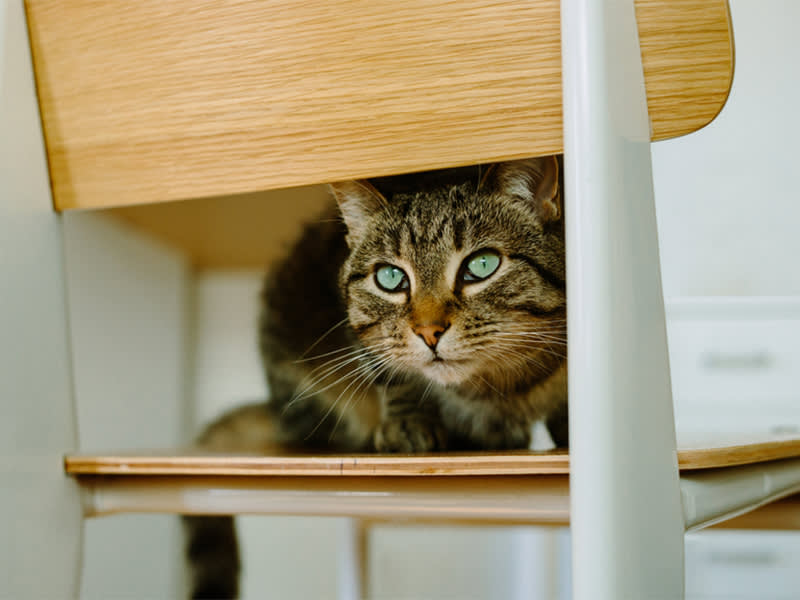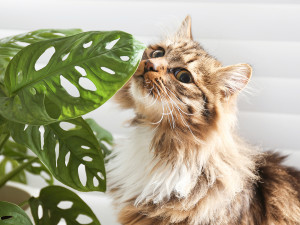How to Cat-Proof Your House
Ten steps for keeping your cat out of trouble.

Share Article
OK, so, you’ve done it. You’ve listed out your pros and cons and every last toy, treat, and accessory you need. Now, you’re bringing home a cat. You can’t wait to have snuggle seshes on the couch and play fetch (yep, it’s not just for dogs). But cats are known for their curiosity, which means you can count on them getting into, well, everything — including but not limited to your curtains, precious heirlooms, and your couch, which looks like an attractive scratching post. And as invincible as cats appear to be, they can actually hurt themselves in the process.
That’s why it’s crucial to cat-proof your home before you welcome them home. “Think of it as preparing your house for a new baby…if babies could jump,” says certified cat behaviorist Marilyn Kriegeropens in new tab. “Some breeds, like Bengals and Savannahs, are good at opening doors, while Maine Coons are really smart — they watch and learn from people.” And kittens of any breed are mischievous, albeit adorable, little beasties. Safeguard your cat — and your stuff — with Krieger’s cat-proofing tips.
1. Keep breakable objects out of reach.
Anything fragile (or important to you) should be tucked away in a cabinet until you can trust your cat not to knock it over.
2. Anchor unsteady or top-heavy furniture to the wall.
Think: flat-screen TVs, wobbly bookshelves, or anything else that can fall on top of a cat who has attempted to scale it. A baby-proofing anti-tip kit can help.

3. Cover your electric cords, cables, and phone chargers.
Cats love to chew stringy things, so to avoid the dangers of electricity, tape wires to the floor with flat strips of vinyl. On that note, don’t leave out any actual string, yarn, rubber bands, dental floss, hair ties...the list goes on. “You do not want them playing with any of that,” Krieger adds. “They can easily strangle themselves or ingest it.”
4. Make sure your windows are secure.
If you open them often, you should install a screen so your cat can’t sneak outside. And the same goes for blind cords — tie ’em up or simply cut them. Window treatments without looped cords are safest for cat households.
5. Toss or give away any poisonous plants.
Many plants and flowers are toxic to cats — especially lilies, irises, poinsettias, and sago palms. Safe alternatives are orchids and African violets — your cat can nibble on them with abandon (if you don’t mind).
6. Close or lock kitchen cabinets.
Many human foods are also toxic to pets, including chocolate, grapes, and raisins. “Don’t let your cat clean your plate,” Krieger says. And don’t forget the potentially dangerous medication, vitamins, or supplements in your cabinets.
7. Put away household cleaners.
Chemical cleaners, bleach, and pine-and phenol-based cleaners can poison your cat, so be sure to keep them in secured containers in a cabinet. And if your cat has access to your garage, keep the anti-freeze well out of reach — it smells sweet to animals but is highly toxic.
8. Keep any and all receptacles covered.
That means trash cans lidded, washer/dryer doors shut, and toilet seats down — basically, anything that a cat can jump or fall into. And plastic trash bags, for that matter, are just as dangerous: Some cats like to play with them as much as cardboard boxes — so don’t leave them lying around after you put away the groceries.
9. Cat-proof your couch.
To protect your sofa and furniture from becoming a scratching post, cover those surfaces and reinforce with double-sided sticky tape. Then, put an actual scratching post nearby so your cat can indulge their instincts somewhere appropriate (not your vintage loveseat). And get rid of your recliner. Sorry to your dad’s favorite chair in your house. Krieger warns that cats often get caught underneath.
10. Hide away sharp objects.
That magnetic knife rack that makes you feel like a profesh chef? Not super safe for cats who like to prowl the kitchen late at night. Also hide away scissors and razors.
It’s a lot, we know. Fur, spills, hairballs, and more dubious messes are par for the course of being a pet parent. But these precautions will keep your new cat (and your entire house) safe.

Kellie Gormly
Kellie B. Gormly is an award-winning journalist based in Pennsylvania who writes for many national publications, including The Washington Post, Woman's World, Catster, and Dogster. Kellie is a volunteer rescuer who fosters kittens and cats at her home, where she has several of her own cats and betta fish.
Related articles
![Man laying on floor playing with dog]()
How to Puppy Proof Your Home
Is your home a danger zone for a new dog? Follow these pro tips.
![cat sniffing a plant]()
Household Plants That Are Toxic to Cats
These plants might be beautiful, but they’re deadly to feline foragers.
![A woman with curly black hair sitting in front of a dark purple and yellow backdrop while looking down affectionately at her two cats sitting on her lap]()
How to Build Your New Cat’s Trust in You
If your cat still approaches you with a figurative arched eyebrow of skepticism, try these tricks to put them at ease.
![Kitten scratching fabric sofa]()
How to Stop Your Cat From Absolutely Ripping Apart Your Couch
Placing a cat tree or post in a room only, uh, scratches the surface of solving this problem.






